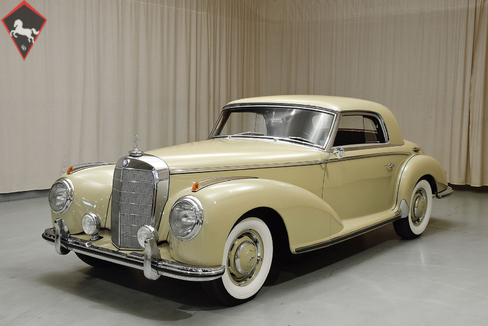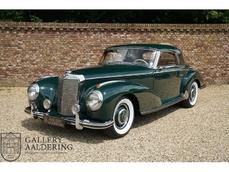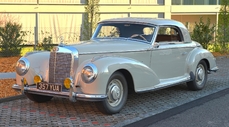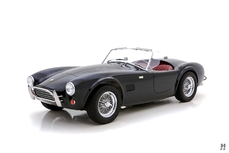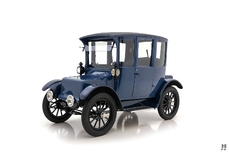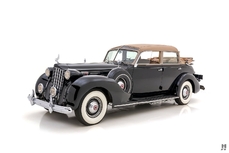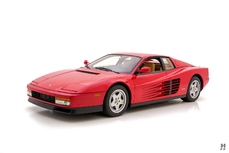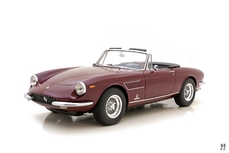Mercedes-Benz 300S / Sc Coupé W188 1954
General description :
The Mercedes-Benz 300S was one of the world’s most exclusive automobiles between 1951 and 1958, introduced at the 1951 Paris Auto Show based on the stately Mercedes-Benz 300 sedan. The W186 300 was Mercedes-Benz’s first all new post-war automobile design, considered, then and now, to be one of the finest engineered automobiles of its era. While the 300 set standards for luxury and performance, the engineering and platform also gave rise to the exemplary, limited production 300S and the later 300SL racing and sports cars. The Mercedes-Benz 300 series re-established the German automaker’s pre-war reputation as one of the world’s most prestigious manufacturers, engineering and building high-performance luxury cars, often by hand, utilizing the finest materials. The 300S was intended more than a little to recall the great pre-war 500K and 540K sports luxury models. The comparison is apt. The 300S shared most of the components of the 300, but rode on a shortened 114.2-inch wheelbase to enhance handling and offered the most powerful engine available, a 3.0-liter ohc in-line six tuned to provide 150 hp and 178 ft-lb of torque with three dual-throat Solex carburetors for the early S model. The chassis features independent suspension and power-assisted brakes on all four wheels.
Even the proportions of the 300S recall the great pre-war Mercedes, successfully creating a bridge between classic pre-war and post-war styles. The real greatness of the 300S, though, came in production. The 300S was offered in two-seat coupe, cabriolet and roadster body styles, with a total of only 580 examples constructed including just 216 coupes. The bodies were entirely hand-built and trimmed by the most senior craftsmen at Mercedes’ Sindelfingen body works. The same craftsmanship and attention to detail are apparent in the interiors. The entire dashboard save for a polished strip locating the switchgear is handmade from burled walnut. The wood trim covers the windshield surround and the top of the doors before continuing in an exquisite, uninterrupted loop across the top of the occasional rear seat. Seats, door panels and the lower dash panel are covered in the highest quality leather, pleated on the seats and doors.
The 300S was both rarer and more expensive than a 300SL when new. Celebrity owners included Aga Khan, Gary Cooper and Cary Grant. This example, finished in DB157 Grau Beige with green leather, was delivered new to the US, on March 16, 1954 as a “direct sale” from Mercedes to Mr. Hatch. Mr. Hatch's Mercedes Coupe arrived looking identical to how we see it today, an undeniably elegant combination, a statement of both its period and the classy tastes of its owner. Fanatically restored some years ago, and showing just 68 miles since restoration, the condition belies the age of the restoration, instead it appears to be very recent, and is difficult to fault. The car runs and drives very well, and retains its original matching number motor. The panel fit, paint and exterior trim are all to the highest standards. The wide whitewall Firestone bias ply tires are correct to the era. The interior is extraordinary, particularly in the pleasing contrast between the burl walnut trim and the green hides. In the day, 300S interiors were compared favorably with contemporary Rolls-Royces and the same is still true today. There is nothing to criticize. The Becker Mexico radio mounted in the dash and all controls work properly. Both the interior and the underhood area display an extraordinary level of detailing with factory delivery tags and service decals, including the break-in instruction decal affixed to the inside of the windshield. The trunk is similarly flawless, with a single spare providing additional space compared with the dual-spare option. Included with the car is a copy of the build record, as well as a set of factory tools.
This is an exceptional automobile that would be welcomed at concours d’elegance, priced at a fraction of the ever-increasing prices of 300SLs and more comfortable, but valued exponentially more than 300 Sedans. Mercedes contemporary marketing described these Coupes as being 'for connoisseurs with individual taste' - a sentiment which surely holds true to this day.
http://hymanltd.com/vehicles/5680-1954-mercedes-benz-300s-coupe/
1954 Mercedes-Benz 300S / Sc Coupé W188 is listed sold on ClassicDigest in St. Louis by Mark Hyman for $575000.
Car Facts
Car type : Car Make : Mercedes-Benz Model : 300S / Sc Coupé W188 Engine size : 0.0 Model Year : 1954 Sub type : Coupé Location : Missouri
Sold
Seller Information
Sold
People who viewed this Mercedes-Benz 300S / Sc Coupé W188 also viewed similar Mercedes-Benz listed at ClassicDigest
Other cars listed for sale by this dealer
About Mercedes-Benz
In the annals of automotive history, the journey of Mercedes-Benz is a tale that unfolds with the ingenuity of its founding pioneers. In the year 1886, Karl Benz crafted the Benz Patent Motorwagen, a creation that would go down in history as the world's inaugural automobile. Unbeknownst to him, this moment marked the genesis of what would evolve into the most illustrious premium car manufacturer globally. The financial underpinning of this pioneering venture, interestingly, was provided by Karl Benz's wife, Bertha Benz, demonstrating a remarkable partnership that would set the tone for Mercedes-Benz's legacy.A parallel narrative emerged not far away, as Daimler-Motoren-Gesellschaft, founded by Gottlieb Daimler and Wilhelm Maybach, entered the scene. In 1901, they unveiled their automobile under the now-famous moniker "Mercedes," meaning "godsend" in Spanish. This name was bestowed upon the car at the behest of Emil Jellinek's daughter, the distributor for Daimler-Motoren-Gesellschaft. The wheels of innovation were set in motion.
Fast forward to 1926, a pivotal year that witnessed the merger of Daimler with Benz & Cie., culminating in the birth of Daimler-Benz. The amalgamation saw the adoption of "Mercedes-Benz" as the distinguished trademark for their automobiles, fusing the legacies of two visionary entities into one.
Contrary to perceptions of conservatism, the trajectory of Daimler-Benz unfolds as a chronicle of industry firsts. From the introduction of the honeycomb radiator to the float carburetor, and the pioneering implementation of four-wheel brakes in 1924, Daimler-Benz consistently pushed the boundaries of automotive innovation. The diesel-powered Mercedes-Benz 260 D in 1936 marked the inception of diesel engines in passenger cars. The iconic Mercedes-Benz 300SL Gullwing made history as the first car with direct fuel injection, albeit the Gutbrod's tiny 2-stroke engine can claim precedence.
Safety innovations became a hallmark, with Béla Barényi's patented safety cell design in the "Ponton"-models in 1951, featuring front and rear crumple zones. The W116 450SEL 6.9 saw the introduction of the Anti-Lock Brake system (ABS), another pioneering safety feature. From the first production airbags and beyond, the legacy of "firsts" continued to be etched into the fabric of Daimler-Benz.
Over its centennial journey, Mercedes-Benz has not merely produced cars but has sculpted automotive icons. The SSKL, 710 SSK Trossi Roadster, 770K Grosser, 540K Spezial Roadster, 300SL Gullwing, w100 600 Pullman, w111 280SE 3.5 Flachkühler, w113 230SL Pagoda, w109 300 SEL 6.3, and w201 2.3-16 Cosworth stand testament to the brand's commitment to engineering excellence.
The roaring Silver Arrows, or "Silberpfeile," including the W 25, W 125, W154, W165, and W196, created a legacy of dominance on the racetrack. These machines were not merely cars; they were expressions of precision, speed, and an indomitable spirit that left their competitors in the dust.
As Mercedes-Benz marches into the future, it does so not just as an automaker but as a custodian of a legacy, a torchbearer of innovation, and a beacon of automotive excellence. The road ahead is sure to witness the continued fusion of cutting-edge technology, timeless design, and an unwavering commitment to setting new standards in the world of automobiles.
One luminary figure who left an indelible mark was Béla Barényi, often heralded as the "father of passive safety" for his pioneering work in safety engineering. His patented safety cell design, featuring front and rear crumple zones, became a hallmark of Mercedes-Benz's commitment to occupant safety, setting new standards that reverberated throughout the automotive world.
Moving through the chronicles, the collaborative genius of Wilhelm Maybach, alongside Gottlieb Daimler, laid the foundation for Daimler-Motoren-Gesellschaft. Their innovations not only birthed the first Mercedes but established a culture of relentless pursuit of technological excellence that remains integral to Mercedes-Benz's DNA.
In the post-merger era of 1926, Ferdinand Porsche emerged as a prominent figure within Mercedes-Benz. His work on the Mercedes-Benz S-Type, a supercharged race car, garnered acclaim and set the stage for a legacy that extended far beyond the marque. Porsche's impact would later extend to his eponymous company, but his influence at Mercedes-Benz during those formative years was pivotal.
As the 20th century progressed, the legendary Rudolf Uhlenhaut emerged as a key figure. Uhlenhaut, an accomplished engineer and the driving force behind the iconic Silver Arrows, played a crucial role in Mercedes-Benz's dominance in motorsports. His engineering prowess and attention to detail were instrumental in creating some of the most formidable racing cars of the era.
In the latter half of the century, figures like Bruno Sacco, the head of design at Mercedes-Benz from 1975 to 1999, left an indelible imprint on the brand's aesthetic identity. Sacco's design philosophy, characterized by clean lines and timeless elegance, shaped iconic models like the W126 S-Class and the W201 190E, solidifying Mercedes-Benz's reputation for luxury and sophistication.
The narrative would be incomplete without acknowledging the contributions of engineers like Hans Scherenberg, whose leadership in the 1970s ushered in a new era of technological innovation at Mercedes-Benz. Scherenberg's tenure saw the development of groundbreaking technologies, including the Anti-Lock Brake system (ABS) and the introduction of airbags in production cars.
